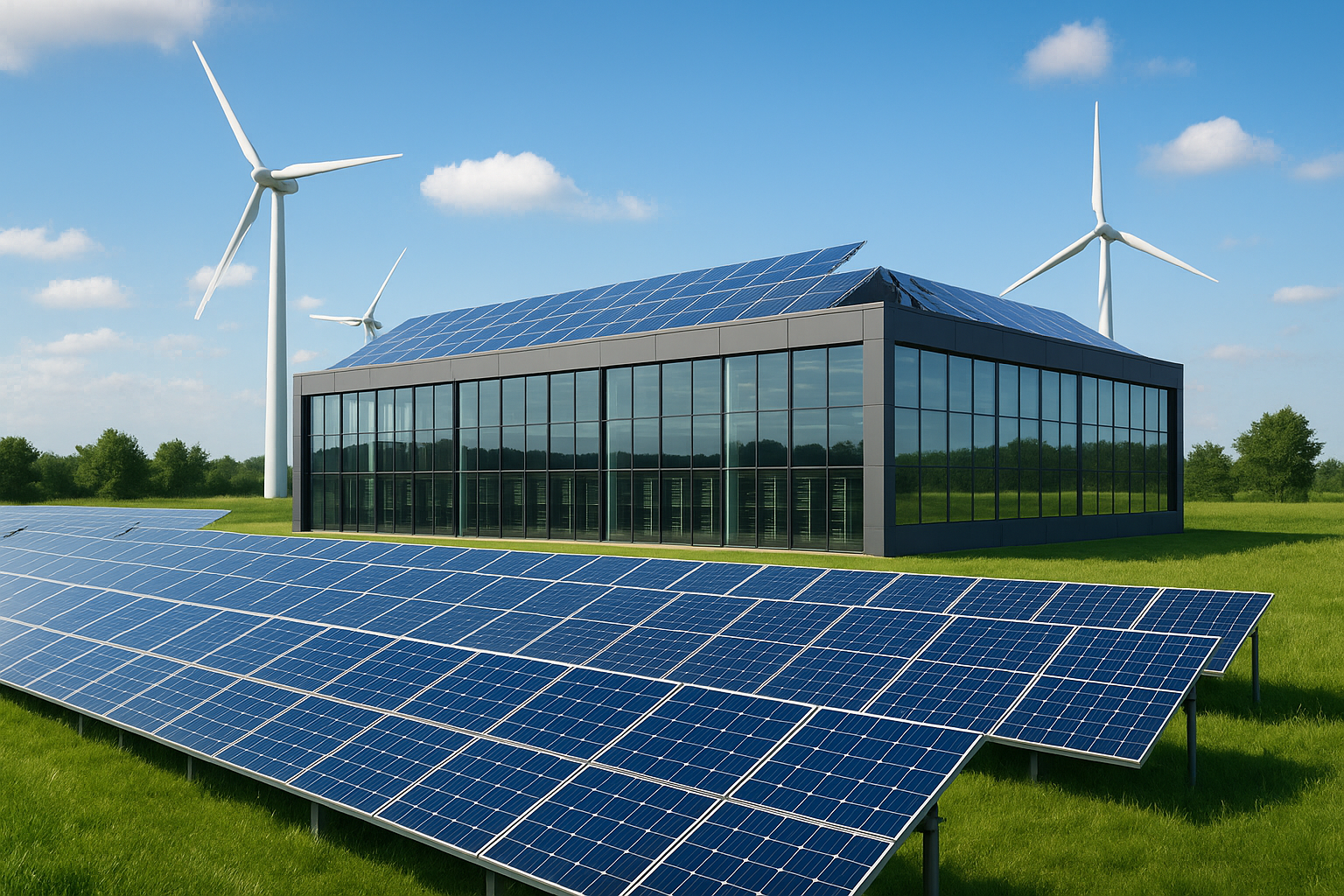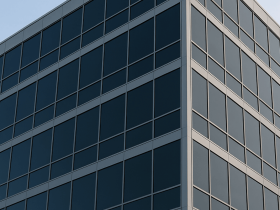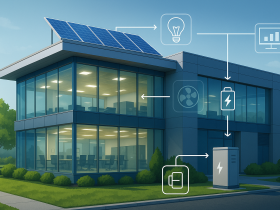Data centers consume about 1–1.3% of the world’s electricity, and that number is only expected to grow as demand for digital services increases. With the explosive rise in cloud computing, AI, and data storage needs, energy efficiency is no longer a luxury. As the backbone of our digital world, data centers face mounting pressure to reduce their environmental footprint while still delivering high performance and reliability. The International Energy Agency (IEA) projects that global electricity use from data centers could more than double by 2030.
Energy efficient data centers are now at the center of global sustainability efforts. From governments tightening regulations to customers demanding greener operations, there’s a clear shift toward smarter, cleaner infrastructure. This blog explores how data centers can reduce energy use, cut costs, and contribute to a more sustainable future through innovative design, technology, and operations.
Key points this article covers:
- Why improving energy efficiency in data centers is critical for both the environment and business.
- The true cost of inefficient energy use — from high utility bills to increased carbon emissions.
- Key drivers behind the push for greener data centers, including regulations and customer expectations.
- Proven strategies for designing and operating energy efficient facilities — from cooling systems to renewable energy.
- How to monitor, measure, and continuously improve energy performance over time.
By the end of this post, you’ll understand how to build or upgrade a data center that not only uses less power but also supports long-term sustainability goals — without compromising on performance.
Understanding Energy Use in Data Centers
Before implementing energy-saving strategies, it’s important to understand where and how energy is consumed in a data center. Most of the power goes to running IT equipment and keeping it cool. The rest is used for lighting, power conversion, and support infrastructure.
Power Distribution and IT Load
The core of any data center is its IT load, which includes servers, storage systems, and networking gear. These devices require consistent and reliable electricity to function, and their energy consumption varies depending on workload and usage patterns.
- Servers consume the most power, especially during peak processing times.
- Storage devices and networking switches also contribute to the electrical load.
- Power losses can occur during conversion and distribution, adding to inefficiency.
Cooling Systems
Cooling is often the second-largest energy consumer in a data center. Servers generate significant heat, and without proper cooling, performance and hardware longevity are at risk. Traditional air conditioning systems are energy-intensive, making thermal management a critical area for improvement.
- Cooling systems can account for up to 40% of a data center’s total energy use.
- Inefficient airflow or overcooling leads to wasted energy.
- Advanced cooling technologies can drastically reduce this burden.
Power Usage Effectiveness (PUE)
PUE is the most widely used metric for data center energy efficiency. It’s calculated by dividing the total facility energy by the energy used by IT equipment. A PUE of 1.0 means all energy is going directly to computing, which is ideal but rarely achieved.
- PUE = Total Facility Energy ÷ IT Equipment Energy.
- The closer the PUE is to 1.0, the more efficient the data center.
- The industry average PUE is around 1.57, but best-in-class facilities achieve below 1.2. Some advanced facilities, such as those using immersion cooling, have reported PUEs as low as 1.01. Google’s data centers average around 1.1, with some sites dropping below 1.06.
Designing for Efficiency from the Ground Up
Energy efficiency starts with smart design. Choices made during the planning and construction phase have a long-term impact on how much energy a facility uses.
Site Selection and Climate Considerations
Location plays a big role in energy efficiency. Cooler climates reduce the need for active cooling, while access to renewable energy sources can support sustainability goals.
- Regions with low ambient temperatures allow for free cooling opportunities.
- Proximity to hydroelectric or wind power sources lowers carbon footprint.
- Stable electrical grids help avoid costly backup power systems.
Facility Layout and Airflow Management
How equipment is arranged inside the data center affects airflow and cooling efficiency.
- Hot aisle/cold aisle configurations separate intake and exhaust air.
- Containment systems prevent air mixing and temperature loss.
- Strategically positioned cooling units balance airflow across the facility.
Scalable, Modular Infrastructure
A modular design allows data centers to grow efficiently.
- Modular units can be pre-fabricated and deployed as needed.
- Smaller, targeted cooling and power systems improve localized efficiency.
- This approach reduces capital expenditure and aligns energy use with actual demand.
Cooling Innovations and Best Practices
Modern cooling technologies are reshaping how data centers manage heat.
Free Cooling and Outside Air Economization
- Reduces energy consumption by bypassing compressors and chillers.
- Can be used year-round in cooler regions with the right filtration systems.
- Helps lower PUE by reducing non-IT energy loads.
Liquid Cooling Technologies
- Direct-to-chip cooling removes heat at the source.
- Immersion cooling submerges servers in dielectric fluid for maximum heat transfer.
- Supports higher computing densities without increasing energy use.
AI and Smart Cooling Controls
- Predictive algorithms prevent hotspots and overcooling.
- Self-learning systems adapt to seasonal and operational changes.
- Reduces manual intervention and improves overall efficiency.
Energy-Efficient Hardware Choices
Low-Power Servers and Components
- ARM-based processors offer high efficiency for certain workloads.
- SSDs consume less power and generate less heat than hard drives.
- Efficient power supplies reduce conversion losses.
Virtualization and Server Consolidation
- Running multiple virtual machines on a single physical server reduces the number of servers required.
- Higher utilization lowers idle energy use and reduces cooling demands.
- Enables dynamic resource allocation based on demand.
Equipment Lifecycle and Upgrades
- Newer servers can deliver twice the performance at half the power.
- Phasing out legacy systems reduces maintenance and power costs.
- Trade-in and recycling programs support sustainability goals.
Renewable Energy Integration
On-Site Solar and Wind Installations
- Solar arrays can be installed on rooftops or adjacent land.
- Wind turbines are effective in regions with consistent wind patterns.
- On-site generation provides energy independence and cost control.
Power Purchase Agreements (PPAs)
- Long-term contracts provide price stability and predictability.
- Offsets carbon emissions even if on-site generation isn’t possible.
- Enables access to green power in regions with limited supply.
Energy Storage and Grid Management
- Battery storage supports backup power and peak shaving.
- Smart grid integration enables demand response and load shifting.
- Improves reliability and reduces strain on utilities.
Monitoring and Optimization
Real-Time Energy Monitoring Tools
- Dashboards provide instant visibility into power use.
- Alerts flag abnormal consumption or system failures.
- Data-driven insights support better decision-making.
Predictive Maintenance
- Prevents equipment failures before they occur.
- Reduces downtime and unnecessary energy waste.
- Optimizes maintenance schedules based on real conditions.
Benchmarking and Continuous Improvement
- Use PUE and other metrics to track efficiency progress.
- Set yearly reduction targets for energy use.
- Refine strategies based on performance data.
Conclusion
As digital infrastructure continues to expand, the importance of energy efficient data centers cannot be overstated. From smarter facility design and innovative cooling technologies to hardware optimization and renewable energy integration, every aspect of a data center presents an opportunity to reduce energy use and environmental impact.
By applying the strategies explored in this guide, such as improving airflow, choosing energy-efficient equipment, and leveraging real-time monitoring tools, organizations can not only lower operational costs but also align with global sustainability goals.
Whether you’re planning a new facility or optimizing an existing one, investing in energy efficiency is a strategic move that pays dividends in performance, reliability, and environmental responsibility.



